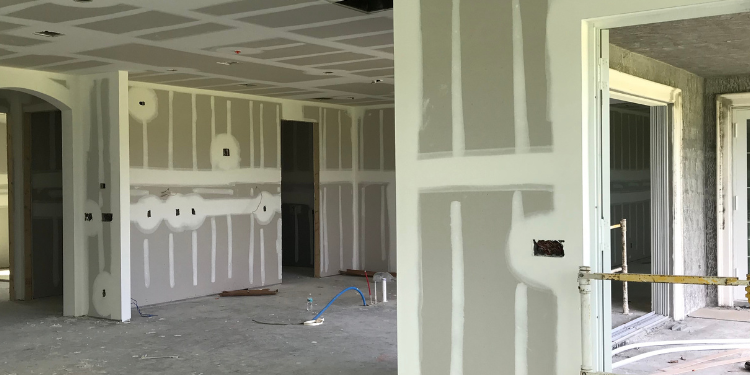In Allen, TX, where home aesthetics are a point of pride, a flawless paint job is often the finishing touch that brings a room to life. However, even the best paint can’t conceal underlying problems caused by poor drywall installation. At MJ Workforce Solutions, we understand how crucial a smooth, properly installed drywall surface is to the success of any painting project. Homeowners often focus on choosing the right paint color or finish, but neglecting the drywall stage can result in costly do-overs and disappointing results.
Whether you’re looking to refresh your space with a splash of color or planning a full renovation, avoiding drywall mistakes is essential for achieving a polished, lasting look. Let’s explore the most common drywall installation errors that can ruin a professional paint job—and how you can prevent them.
Key Takeaway: A beautiful paint finish begins with precise drywall work. Inadequate drywall preparation or installation can lead to peeling, bubbling, cracks, and unsightly seams that ruin the final aesthetic.
Poor Joint Treatment
Misaligned Taping and Inconsistent Mud Application
Taping seams is a critical step in any drywall repair and installation project. When taping is rushed or poorly executed, the paint will highlight every flaw. Misaligned tape can cause visible lines or ridges to appear, especially under bright lighting. Uneven mudding often results in bumpy or patchy wall surfaces, which are impossible to mask with paint.
Skipping Sanding Between Coats
Each layer of joint compound should be sanded thoroughly before the next is applied. Skipping this process leaves behind lumps and inconsistencies. These imperfections become more noticeable after interior painting, leading to a finish that looks amateurish, regardless of paint quality.
Using the Wrong Drywall Tape
Mesh tape, while easy to apply, isn’t ideal for every job. In high-humidity areas or ceilings, it can break down over time. Paper tape is more durable and creates a stronger bond. Choosing the wrong tape compromises the integrity of the wall and can affect how well the paint adheres to the surface.
Uneven Drywall Surface
Over-Driving Screws and Nails
When screws or nails are driven too deep into drywall, they crush the gypsum core, weakening the panel. This leads to dimples and craters in the wall that become magnified when painted. Proper screw setting ensures a level surface and minimizes repair needs.
Poorly Cut Drywall Edges
Rough or jagged edges create seams that are difficult to blend. When seams are not flush, they leave behind visible lines that no amount of paint or primer can hide. Precision cutting is key for tight, seamless drywall joints.
Failing to Use a Level
One of the most overlooked aspects of drywall installation is ensuring each sheet is level and aligned. Walls that are out of plumb or crooked will produce uneven shadows and distort the visual appeal of a painted room.
Moisture and Mildew Problems
Installing on Damp Surfaces
Moisture is a paint job’s worst enemy. Drywall must be installed on a dry surface, free of moisture or mildew. Ignoring signs of water damage can lead to bubbling, blistering paint, and long-term structural issues. Moisture barriers and proper ventilation are vital, especially in Allen’s variable climate.
Not Sealing Cut Edges
Drywall is porous and can absorb moisture easily. When edges are left unsealed, they become vulnerable to mold and mildew, which eventually bleeds through the paint. A moisture-resistant primer or sealant protects these vulnerable areas before the first coat of paint is applied.
Inadequate Ventilation in Bathrooms and Kitchens
High-moisture areas require special attention. If proper drywall types, such as green board or moisture-resistant drywall, aren’t used, the surface can break down over time. Interior house painters in Allen often see bubbling paint caused by hidden water damage behind walls.
Skipping Surface Preparation
Not Cleaning Dust and Debris
Even a perfectly installed wall can be ruined if it’s not properly cleaned before painting. Dust from sanding must be removed with a damp cloth or vacuum. Leftover particles interfere with paint adhesion and create a gritty texture.
Forgetting Primer
Primer is non-negotiable. It seals the drywall, provides a uniform base, and prevents flashing (uneven paint appearance). A quality primer ensures that topcoats stick better and last longer, which is why professional painting companies prioritize this step.
Using the Wrong Primer Type
Not all primers are created equal. In areas like kitchens or laundry rooms, stain-blocking or moisture-resistant primers may be necessary. The wrong primer can lead to poor paint coverage and increased paint usage.
Paint Application Challenges
Painting Over Poorly Installed Drywall
Even the most skilled residential painting company can’t make up for a bad foundation. If drywall has bulges, cracks, or gouges, the final result will be compromised. Investing in professional drywall installation ensures your paint finish is smooth and durable.
Ignoring Temperature and Humidity
In Allen, TX, temperatures can vary significantly throughout the year. Painting during high humidity or extreme cold can cause paint to dry too slowly or quickly, affecting the final look. Proper drywall acclimation before painting is critical.
Applying Paint Before Joint Compound Cures
Drywall mud needs adequate time to dry. Painting too soon traps moisture, which may lead to peeling or bubbling. A little patience ensures a longer-lasting finish.
Answering Common Questions
What’s the most common drywall mistake that affects painting?
Improper joint treatment is the most frequent issue. Gaps, bumps, and uneven seams make the paint job look rushed and unprofessional. Always ensure joints are smooth and sanded.
Can I paint directly on new drywall?
No. New drywall should be primed before painting. Primer seals the surface and helps paint adhere more effectively, preventing blotchy or uneven finishes.
How can I fix peeling paint caused by drywall issues?
The wall must be sanded, cleaned, and re-primed. In some cases, damaged drywall must be replaced. For full restoration, consider paint removal services followed by proper prep and repainting.
How Poor Drywall Affects Exterior Painting
Exterior drywall or wallboard in covered patios or garages is still vulnerable to moisture intrusion and surface irregularities. This can increase the exterior painting cost due to the additional labor required to smooth and seal the surfaces. Prep time is often doubled when the surface is not properly finished to begin with.
The Link Between Drywall and Faux Finishes
Faux painting techniques such as Venetian plaster or sponge finishes rely on a flawless foundation. A single dent or uneven patch can ruin the illusion. For homeowners in Allen considering faux painting services, professional drywall prep is essential to achieve high-end results.
Trust MJ Workforce Solutions for Flawless Results
If you’re planning a painting project in Allen, TX, don’t let drywall errors stand in your way. At MJ Workforce Solutions, our team specializes in seamless drywall installation services, ensuring that your home looks polished from the inside out. Whether you need help with wallpaper installation, popcorn texture removal, or deck staining services, we have the experience and attention to detail your project deserves.
Reach out today to schedule a consultation and transform your home with confidence—because beautiful paint starts with perfect prep.







